
Russian American Telegraph
Encyclopedia
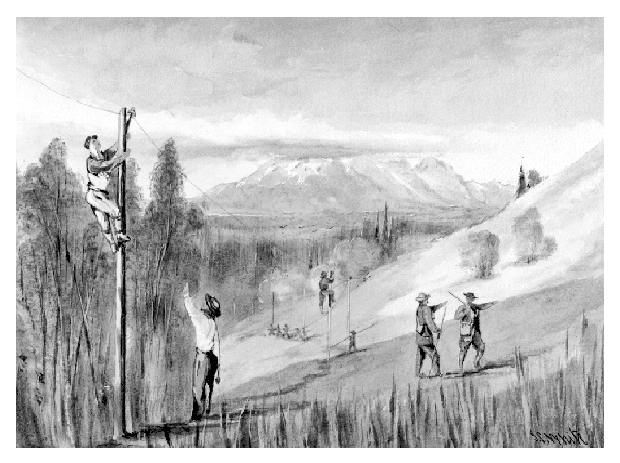
San Francisco, California
San Francisco , officially the City and County of San Francisco, is the financial, cultural, and transportation center of the San Francisco Bay Area, a region of 7.15 million people which includes San Jose and Oakland...
to Moscow, Russia.
The route was intended to travel from California via Oregon
Oregon
Oregon is a state in the Pacific Northwest region of the United States. It is located on the Pacific coast, with Washington to the north, California to the south, Nevada on the southeast and Idaho to the east. The Columbia and Snake rivers delineate much of Oregon's northern and eastern...
, Washington Territory
Washington Territory
The Territory of Washington was an organized incorporated territory of the United States that existed from February 8, 1853, until November 11, 1889, when the final extent of the territory was admitted to the Union as the State of Washington....
, the Colony of British Columbia
Colony of British Columbia
The Colony of British Columbia was a crown colony in British North America from 1858 until 1866. At its creation, it physically constituted approximately half the present day Canadian province of British Columbia, since it did not include the Colony of Vancouver Island, the vast and still largely...
and Russian America, under the Bering Sea
Bering Sea
The Bering Sea is a marginal sea of the Pacific Ocean. It comprises a deep water basin, which then rises through a narrow slope into the shallower water above the continental shelves....
and across Siberia
Siberia
Siberia is an extensive region constituting almost all of Northern Asia. Comprising the central and eastern portion of the Russian Federation, it was part of the Soviet Union from its beginning, as its predecessor states, the Tsardom of Russia and the Russian Empire, conquered it during the 16th...
to Moscow, where lines would communicate with the rest of Europe. It was proposed as an alternate to long, deep underwater cables in the Atlantic.
Abandoned in 1867, the Russian–American Telegraph was considered an economic failure, but history now deems it a "successful failure" because of the many benefits the exploration brought to the regions that were traversed.
Perry Collins and Cyrus West Field

Working to meet that challenge was Cyrus West Field
Cyrus West Field
Cyrus West Field was an American businessman and financier who, along with other entrepreneurs, created the Atlantic Telegraph Company and laid the first telegraph cable across the Atlantic Ocean in 1858.-Life and career:...
's Atlantic Telegraph Company
Atlantic Telegraph Company
The Atlantic Telegraph Company was a company formed in 1856 to undertake and exploit a commercial telegraph cable across the Atlantic ocean, the first such telecommunications link....
, who in 1858 had laid the first undersea cable
Submarine communications cable
A submarine communications cable is a cable laid on the sea bed between land-based stations to carry telecommunication signals across stretches of ocean....
across the Atlantic Ocean
Atlantic Ocean
The Atlantic Ocean is the second-largest of the world's oceanic divisions. With a total area of about , it covers approximately 20% of the Earth's surface and about 26% of its water surface area...
. However, the cable had broken three weeks afterwards and additional attempts had thus far been unsuccessful.
Meanwhile, entrepreneur Perry Collins
Perry Collins
Perry McDonough Collins was the visionary behind the Russian American Telegraph of 1865-1867. The failed venture aimed to connect America to Europe by telegraph via the Bering Strait.-The early years:...
visited Russia and took note that it was making good progress extending its telegraph lines eastwards from Moscow over Siberia.
Upon his return to the States, Collins approached Hiram Sibley
Hiram Sibley
Hiram Sibley , was an industrialist, entrepreneur, and philanthropist.Sibley was born in North Adams, Massachusetts, and later resided in Rochester, New York. He became interested in the work of Samuel Morse involving the telegraph.In 1840, he joined with Morse and Ezra Cornell to create a...
, head of the Western Union Telegraph Company with the idea of an overland telegraph line that would run through the Northwestern states, the colony of British Columbia and Russian Alaska. Together, they worked on promoting the idea and obtained considerable support in the US, London and Russia.
Preparations

President of the United States
The President of the United States of America is the head of state and head of government of the United States. The president leads the executive branch of the federal government and is the commander-in-chief of the United States Armed Forces....
Abraham Lincoln
Abraham Lincoln
Abraham Lincoln was the 16th President of the United States, serving from March 1861 until his assassination in April 1865. He successfully led his country through a great constitutional, military and moral crisis – the American Civil War – preserving the Union, while ending slavery, and...
granted the company a right of way from San Francisco to the British Columbia border and assigned them the steamship Saginaw
USS Saginaw (1859)
The first USS Saginaw was a sidewheel sloop-of-war in the United States Navy during the American Civil War.-History:The first vessel built by the Mare Island Navy Yard, Saginaw was laid down on 16 September 1858; launched as Toucey on 3 March 1859; sponsored by Miss Cunningham, daughter of the...
from the US Navy.
The George S Wright and the infamous Nightingale
USS Nightingale (1851)
USS Nightingale was originally the tea clipper and slave ship Nightingale, launched in 1851. She was captured in Africa in 1861 by , taken as a prize and purchased by the United States Navy....
, a former slave ship
Slave ship
Slave ships were large cargo ships specially converted for the purpose of transporting slaves, especially newly purchased African slaves to Americas....
, were also put into service, as well as a fleet of riverboat
Riverboat
A riverboat is a ship built boat designed for inland navigation on lakes, rivers, and artificial waterways. They are generally equipped and outfitted as work boats in one of the carrying trades, for freight or people transport, including luxury units constructed for entertainment enterprises, such...
s and schooner
Schooner
A schooner is a type of sailing vessel characterized by the use of fore-and-aft sails on two or more masts with the forward mast being no taller than the rear masts....
s.
To supervise the construction, Collins chose Colonel Charles Bulkley, who had been the Superintendent of Military Telegraphs. Being an ex-military man, Bulkley divided the work crews into "working divisions" and an "Engineer Corps".
Edward Conway was made the head of the project's American route and British Columbia sections. Franklin Pope was assigned to Conway and given the responsibility for the exploring of British Columbia. The task of exploring Russian America went to the Smithsonian naturalist
Naturalist
Naturalist may refer to:* Practitioner of natural history* Conservationist* Advocate of naturalism * Naturalist , autobiography-See also:* The American Naturalist, periodical* Naturalism...
Robert Kennicott
Robert Kennicott
Robert Kennicott was an American naturalist.-Biography:Kennicott was born in New Orleans and grew up in "West Northfield" , Illinois, a town in the prairie north of the then nascent city of Chicago....
. In Siberia, the construction and exploration was under the charge of Russian nobleman Serge Abasa. Assigned to him were Collins Macrae, George Kennan
George Kennan (explorer)
George Kennan was an American explorer noted for his travels in the Kamchatka and Caucasus regions of the Russian Empire. He was a cousin twice removed of diplomat and historian George F. Kennan, with whom he shared his birthday....
and JA Mahood.
Exploration and construction teams were divided into groups: one was in British Columbia, another worked around the Yukon River
Yukon River
The Yukon River is a major watercourse of northwestern North America. The source of the river is located in British Columbia, Canada. The next portion lies in, and gives its name to Yukon Territory. The lower half of the river lies in the U.S. state of Alaska. The river is long and empties into...
and Norton Sound
Norton Sound
Norton Sound is an inlet of the Bering Sea on the western coast of the U.S. state of Alaska, south of the Seward Peninsula. It is about 240 km long and 200 km wide. The Yukon River delta forms a portion of the south shore and water from the Yukon influences this body of water...
with headquarters at St. Michael, Alaska
St. Michael, Alaska
St. Michael is a city in Nome Census Area, Alaska, United States. At the 2000 census the population was 368.-Geography:St. Michael is located at on the east side of St...
, a third explored the area along the on the Amur River in Siberia and a fourth group of about 40 men was sent to Port Clarence
Port Clarence, Alaska
Port Clarence is a census-designated place in Nome Census Area, Alaska. The population was 21 at the 2000 census. It is located on the spit separating the bay of Port Clarence from the Bering Strait.-History:...
to build the line that was to cross the Bering Strait to Siberia.
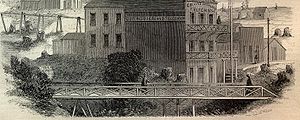
Duty (economics)
In economics, a duty is a kind of tax, often associated with customs, a payment due to the revenue of a state, levied by force of law. It is a tax on certain items purchased abroad...
and tolls
Tariff
A tariff may be either tax on imports or exports , or a list or schedule of prices for such things as rail service, bus routes, and electrical usage ....
. Chosen as the British Columbia terminus, New Westminster gloated over its triumph over its rival, Victoria
Victoria, British Columbia
Victoria is the capital city of British Columbia, Canada and is located on the southern tip of Vancouver Island off Canada's Pacific coast. The city has a population of about 78,000 within the metropolitan area of Greater Victoria, which has a population of 360,063, the 15th most populous Canadian...
, and it was predicted in the British Columbian newspaper that "New Westminster, traduced and dreaded by its jealous neighbor, will now be at the centre of all these great systems". The right of way for the telegraph used the old Semiahmoo Trail to traverse the high ground of what is now the White Rock
White Rock, British Columbia
White Rock is a city in British Columbia, Canada, that lies within the Metro Vancouver regional district. It borders Semiahmoo Bay and is surrounded on three sides by the City of Surrey, British Columbia. To the south lies the Semiahmoo First Nation, which is within the city limits of Surrey...
/South Surrey area of B.C. From Mud Bay the telegraph line followed the Kennedy Trail
Kennedy Trail
The Kennedy Trail was the first settler built trail in the Lower Mainland of British Columbia.James Kennedy first proposed "a trail from some point opposite New Westminster, across to some other point near to Semiahmoo Bay" in a letter written to Governor James Douglas in June 1860.He said "it...
northwest across Surrey and North Delta to the Fraser River.
At Brownsville, an underground cable was laid across the river to New Westminster. The surveying in British Columbia had started before the line reached New Westminster on March 21, 1865. Edward Conway had walked to Hope
Hope, British Columbia
Hope is a district municipality located at the confluence of the Fraser and Coquihalla rivers in the province of British Columbia, Canada. Hope is at the eastern end of both the Fraser Valley and the Lower Mainland region, and is at the southern end of the Fraser Canyon...
and was dismayed by the difficulty of the terrain. In response to Conway's concerns, the Colony of British Columbia agreed to build a road from New Westminster to Yale
Yale, British Columbia
Yale is an unincorporated town in the Canadian province of British Columbia. It was founded in 1848 by the Hudson's Bay Company as Fort Yale by Ovid Allard, the appointed manager of the new post, who named it after his superior, James Murray Yale, then Chief Factor of the Columbia District...
where it would meet the newly completed Cariboo Road
Cariboo Road
The Cariboo Road was a project initiated in 1860 by the colonial Governor of British Columbia, James Douglas...
. The telegraph company's only responsibility would be to string wires along it.
Route through Russian America

Many of the Western Union workers were unaccustomed to severe northern winters and working in frigid conditions made laying the line a difficult experience. Fires had to be lit to thaw out the frozen ground before holes could be dug to place the telegraph poles. For transportation and to haul the supplies, the only option the work crews had was to use teams of sled dogs.
When the Atlantic cable was successfully completed and the first transatlantic message to England was sent in July 1866, the men in the Russian American division were not aware of it until a full year later.
By then telegraph stations had been built, thousands of poles were cut and distributed along the route and over 45 miles of line had been completed in Russian America. Despite the fact that so much progress had been made, in July 1867, the work was officially ceased.
Route through British Columbia
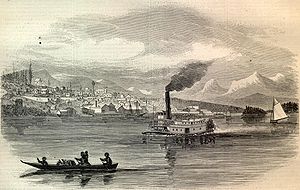
In May 1865 construction began from New Westminster to Yale and then along the Cariboo Road
Cariboo Road
The Cariboo Road was a project initiated in 1860 by the colonial Governor of British Columbia, James Douglas...
and the Fraser River
Fraser River
The Fraser River is the longest river within British Columbia, Canada, rising at Fraser Pass near Mount Robson in the Rocky Mountains and flowing for , into the Strait of Georgia at the city of Vancouver. It is the tenth longest river in Canada...
to Quesnel
Quesnel, British Columbia
-Demographics:Quesnel had a population of 9,326 people in 2006, which was a decrease of 7.1% from the 2001 census count. The median household income in 2005 for Quesnel was $54,044, which is slightly above the British Columbia provincial average of $52,709....
. Winter brought a halt to construction, but resumed in the spring with 150 men working northwest from Quesnel.
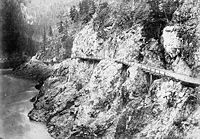
Bulkley River
The Bulkley River in British Columbia is a major tributary of the Skeena River. The Bulkley is 257 km long with a drainage basin covering 12,400 km²....
s. The company's sternwheeler, Mumford, traveled 110 miles up the Skeena River
Skeena River
The Skeena River is the second longest river entirely within British Columbia, Canada . The Skeena is an important transportation artery, particularly for the Tsimshian and the Gitxsan - whose names mean "inside the Skeena River" and "people of the Skeena River" respectively, and also during the...
from the Pacific Coast three times that season, successfully delivering 150 miles of material for the telegraph line and 12,000 rations for its workers.
The line passed Fort Fraser and reached the Skeena River, creating the settlement of Hazelton
Hazelton, British Columbia
Hazelton is a small town located at the junction of the Bulkley and Skeena Rivers in northern British Columbia, Canada. It was founded in 1866 and has a population of 293...
when it was learned that Cyrus West Field had successfully laid the transatlantic cable on July 27.
In British Columbia, construction of the overland line was halted on February 27, 1867, as the whole project was now deemed obsolete.
Nevertheless, left behind in British Columbia was a usable telegraph system from New Westminster to Quesnel, which later would be run to the Cariboo Gold Rush
Cariboo Gold Rush
The Cariboo Gold Rush was a gold rush in the Canadian province of British Columbia. Although the first gold discovery was made in 1859 at Horsefly Creek, followed by more strikes at Keithley Creek and Antler Horns lake in 1860, the actual rush did not begin until 1861, when these discoveries were...
town of Barkerville, and a trail that had been beat through what had largely been uncharted wilderness.

First Nations
First Nations is a term that collectively refers to various Aboriginal peoples in Canada who are neither Inuit nor Métis. There are currently over 630 recognised First Nations governments or bands spread across Canada, roughly half of which are in the provinces of Ontario and British Columbia. The...
inhabitants. Near Hazelton, Colonel Bulkley had been impressed by the bridge the Hagwilgets had built across the Bulkley River, but was reluctant to let his work party cross it until it had been reinforced with cable.

Legacy
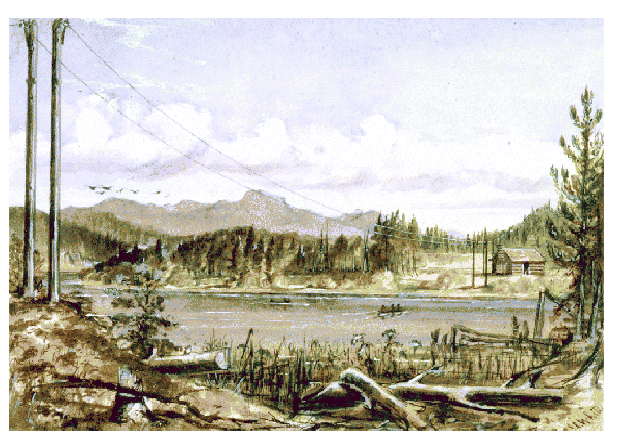
Manifest Destiny
Manifest Destiny was the 19th century American belief that the United States was destined to expand across the continent. It was used by Democrat-Republicans in the 1840s to justify the war with Mexico; the concept was denounced by Whigs, and fell into disuse after the mid-19th century.Advocates of...
beyond its national boundaries and may have precipitated the US purchase of Alaska. The expedition was responsible for the first examination of the flora
Flora
Flora is the plant life occurring in a particular region or time, generally the naturally occurring or indigenous—native plant life. The corresponding term for animals is fauna.-Etymology:...
, fauna
Fauna
Fauna or faunæ is all of the animal life of any particular region or time. The corresponding term for plants is flora.Zoologists and paleontologists use fauna to refer to a typical collection of animals found in a specific time or place, e.g. the "Sonoran Desert fauna" or the "Burgess shale fauna"...
and geology of Russian America and the members of the telegraph project were able to play a crucial role in the purchase of Alaska by providing useful valuable data on the territory.
The Colony of British Columbia meanwhile could further explore, colonize and communicate with its northern landscapes beyond what had been done by the Hudson's Bay Company
Hudson's Bay Company
The Hudson's Bay Company , abbreviated HBC, or "The Bay" is the oldest commercial corporation in North America and one of the oldest in the world. A fur trading business for much of its existence, today Hudson's Bay Company owns and operates retail stores throughout Canada...
.
Many of the towns in Northwestern British Columbia can trace their initial European settlement back to the Collins Overland telegraph. Some examples of these are Hazelton, Burns Lake
Burns Lake, British Columbia
thumb|309px|right|Burns Lake's welcome signBurns Lake is a rural village in the North-Central Interior of British Columbia, Canada, incorporated in 1923...
, Telkwa
Telkwa, British Columbia
Telkwa is a village located along British Columbia Highway 16, nearly 15 km southeast of the town of Smithers and 350 km west of the city of Prince George, in northwest British Columbia, Canada....
and Telegraph Creek
Telegraph Creek, British Columbia
Telegraph Creek is a small community located off Highway 37 in Northern British Columbia at the confluence of the Stikine River and Telegraph Creek. The only permanent settlement on the Stikine River, it is home to approximately 350 members of the Tahltan First Nation, as well as another 50...
.
The expedition also laid a foundation for the construction of the Yukon telegraph line which was built from Hazelton to Telegraph Creek and beyond to Dawson City, Yukon in 1901.
Portions of the telegraph route became part of the Ashcroft trail used by gold seekers during the Klondike gold rush
Klondike Gold Rush
The Klondike Gold Rush, also called the Yukon Gold Rush, the Alaska Gold Rush and the Last Great Gold Rush, was an attempt by an estimated 100,000 people to travel to the Klondike region the Yukon in north-western Canada between 1897 and 1899 in the hope of successfully prospecting for gold...
. Of all the trails used by the stampeders the Ashcroft was among the harshest. Of the over fifteen hundred men and three thousand horses left Ashcroft, British Columbia in the spring of 1898, only six men and no horses reached the goldfields.
Walter R. Hamilton was among those who completed the route. In his book The Yukon Story he describes the state of the trail thirty years after it was abandoned
"All evidence of the right-of-way and poles were gone, but in a few instances we found pieces of old telegraph wire imbedded several inches in the spruce, jack-pine and poplar trees that had long-since grown up and over the wires that touched them. I found one of the old green glass insulators still attached to a galvanized wire. I kept it as a souvenir but lost it later with a camera and some clothing when a scow was nearly overturned on Lake LabergeLake LabergeLake Laberge is a widening of the Yukon River north of Whitehorse, Yukon in Canada. It is fifty kilometres long and ranges from two to five kilometres wide. Its water is always very cold, and its weather often harsh and suddenly variable....
."
Places named for the expedition members
- Mount Pope in British Columbia was named for Franklin Pope, who was the Assistant Engineer and Chief of Explorations, responsible for surveying the 1,500 miles section from New Westminster to the Yukon River.
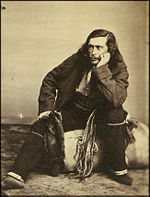
- Kennecott, Alaska and the Kennicott GlacierKennicott GlacierKennicott Glacier is a glacier in the U.S. state of Alaska. It trends southeast 43 km from Mount Blackburn to its terminus at the head of the Kennicott River in the Wrangell Mountains. It is located in the middle of Wrangell-St...
are named for the expedition's naturalist, Robert KennicottRobert KennicottRobert Kennicott was an American naturalist.-Biography:Kennicott was born in New Orleans and grew up in "West Northfield" , Illinois, a town in the prairie north of the then nascent city of Chicago....
. Although Kennicott died on the expedition, on May 13, 1866, his work was publicized by W. H. DallW. H. DallWilliam Healey Dall was an American naturalist, a prominent malacologist, and one of the earliest scientific explorers of interior Alaska...
, another naturalist hired by Robert KennicottRobert KennicottRobert Kennicott was an American naturalist.-Biography:Kennicott was born in New Orleans and grew up in "West Northfield" , Illinois, a town in the prairie north of the then nascent city of Chicago....
. This publication and the publicity about the Kennicott's death at the age of thirty-one helped Secretary of State William H. SewardWilliam H. SewardWilliam Henry Seward, Sr. was the 12th Governor of New York, United States Senator and the United States Secretary of State under Abraham Lincoln and Andrew Johnson...
convince CongressUnited States CongressThe United States Congress is the bicameral legislature of the federal government of the United States, consisting of the Senate and the House of Representatives. The Congress meets in the United States Capitol in Washington, D.C....
to purchaseAlaska purchaseThe Alaska Purchase was the acquisition of the Alaska territory by the United States from Russia in 1867 by a treaty ratified by the Senate. The purchase, made at the initiative of United States Secretary of State William H. Seward, gained of new United States territory...
Alaska from Russia in 1867. - The Bulkley River, Bulkley ValleyBulkley ValleyThe Bulkley Valley is located in the northwest Central Interior of British Columbia, Canada.-Geography:The 257 km long Bulkley River runs through the valley which is bounded on the west by the Hudson Bay Mountain range and on the east by the Babine Mountains...
, Bulkley Mountains (now named the Bulkley RangesBulkley RangesThe Bulkley Ranges is mountain range in northern British Columbia, Canada, located between the Skeena and Bulkley Rivers south of Hazelton, north of the Morice River and Zymoetz River. It has an area of 7851 km2 and is a subrange of the Hazelton Mountains which in turn form part of the...
) and the settlement of Bulkley House in British Columbia are named after Colonel Charles Bulkley. The name of the Bulkley-Nechako Regional District, a regional government in that area, is derived from the geographic names.
Books and memoirs written about the expedition
Several major works are available documenting the expedition. The scientific travelogue by Smithsonian scientist W. H. DallW. H. Dall
William Healey Dall was an American naturalist, a prominent malacologist, and one of the earliest scientific explorers of interior Alaska...
is perhaps the most referenced, while an English travelogue by Frederick Whymper
Frederick Whymper
Frederick Whymper was a British artist and explorer.Whymper was born in London in 1838, the eldest son of Elizabeth Whitworth Claridge and Josiah Wood Whymper, a celebrated wood-engraver and artist...
provides additional information. Among personal accounts members of the expedition are a diary of Franklin Pope.
George Kennan
George Kennan (explorer)
George Kennan was an American explorer noted for his travels in the Kamchatka and Caucasus regions of the Russian Empire. He was a cousin twice removed of diplomat and historian George F. Kennan, with whom he shared his birthday....
and Richard Bush both wrote of the difficulties they encountered during the expedition. Kennan would later become notable for influencing American opinion of the Russian Empire. Originally very much for Russian settlement of the far East, on visiting the exile camps in the 1880s he changed his mind and later wrote Tent Life in Siberia: Adventures Among the Koryaks and Other Tribes in Kamchatka and Northern Asia. Richard Bush, aiming to emulate Kennan's success, wrote "Reindeer, Dogs and Snowshoes".
All documents and books relating to the expedition are of historical value, not only from a travel and discovery perspective but also from a cultural studies standpoint. The ethnocentric descriptions of aboriginal peoples in the places now known as British Columbia, Yukon Territory and Alaska, as well as the general region of Eastern Siberia, typify those attitudes of the time. In hindsight, the descriptions create havoc in modern liberal academia, but they can still be useful. Telegraph records provide evidence for native land claims such as those of the Gitxsan Nation
Gitxsan Nation
Gitxsan Nation is one of Canada's First Nations and is a name used when referring to the Office of the Hereditary Chiefs of the Gitxsan, which is the formal governing body of the Gitxsan people. Their territories are located in the Skeena Watershed of British Columbia, Canada, covering 30,000...
of northern British Columbia. Dall's records have helped locate Smithsonian exhibits returned to their original native domiciles.
Further reading
- Kennan, George1870;reprint 1986 ISBN 0-87905-254-6

